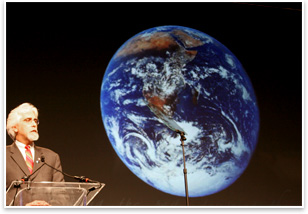
|
A word from the president Summary: What follows is excerpted from President Stewart’s comments at the close of the AIA’s 2007 National Convention in San Antonio.
In the early ’80s the AIA once again takes the lead. This year’s Kemper recipient, Randy Vosbeck, presides over a National Convention which links design with energy. But the public, its representatives, and most of our clients aren’t listening. The nation moves on. Yet the AIA keeps at it. In 1992, the first woman to hold the office of AIA President joins with architects around the world, pledging member countries to pursue conservation. Some industry publications cover it. However, there’s not a mention in the popular press. Now let’s move forward to the National Convention in Las Vegas. It’s 2005 and former AIA President Doug Steidl signs a declaration with his international counterparts that gives priority to the challenge of climate change. Again, a deafening silence outside of the convention hall. But not today! An angel’s-eye view Our convention here in San Antonio has seen a remarkable convergence of scientists, educators, and political leaders that would have been inconceivable even a few years ago. Together they have painted a compelling picture of the challenge of sustainability…of growing beyond green. By their willingness to come here to share their knowledge, they have confirmed that architects and the building industry must play a major part to assure the future of our planet. Some architects will see sustainability as providing them a marketing edge. If that’s what it takes to get them to practice sustainable design; may the gods bless them. Others will be motivated by fear. If it takes fear to focus their attention, well, let’s scare the complacency out of them. However, we will be more creative, achieve more, and be truer to our values as architects if our primary motive is neither profit nor fear. The best and most persuasive argument for sustainability is our belief in the future, our understanding of connectedness, our child-like awe for the wonders of the planet. Committed to doing what’s right The giants of our profession, upon whose shoulders we stand, have taken us part of the way toward a better future. I hope I’ve done my part to build on their legacy to enrich the profession and create a better world. Please, let’s not forget the inspiration we’ve all experienced here. Let’s not lose the momentum to change our practices to create a more sustainable profession and planet. Future generations will judge whether we have been worthy ancestors. How each of us chooses to act—the big and small things we do each day—will change the world. I know what I intend to do. What will be your choice? |
||
Copyright 2007 The American Institute of Architects. All rights reserved. Home Page |
||
news headlines
practice
business
design

